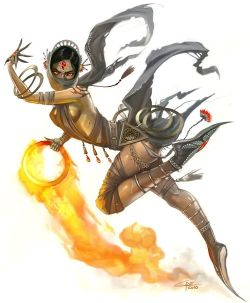Vudra
| Vudra | |

| |
| Nation | |
| Titre | Impossible Kingdoms of Vudra |
| Pays: | {{{land}}} |
| Alignement | |
| Capitale | |
| Dirigeant | Maharajah (current incumbent unknown) |
| Gouvernement | More than a hundred mahajanapadas, or semi-independent kingdoms ruled by rajahs in service of the maharajah |
| natives | Vudrani (singular and plural) |
| adjective | Vudran |
| Languages | Vudrani |
| religions | Thousands of Vudran deities, including Irori |
| regionmap | |
| source | {{{source}}} |
Vudra (pronounced VOO-drah)[1] (also known as Vandu)[2] is a vast peninsula extending from southeastern Casmaron with a total area nearly equal that of Avistan.[3] Vudra is home to the Vudrani, a human ethnicity known for their gregariousness. Also known as the Impossible Kingdoms, Vudra consists of more than one hundred mahajanapadas: semi-independent kingdoms ruled by rajahs. These rajahs in turn serve the maharajah, an emperor-like figure descended from Khiben-Sald, who in his lifetime spent a decade as an honored guest of the ancient Garundi wizard-king Nex.[4]
Most recent contact between Vudra and the Inner Sea region comes as a direct result of Vudrani now dwelling on the Isle of Jalmeray, located in the Obari Ocean between the countries of Nex and Qadira.[5][4]
History
According to the Vudrani people, their homeland has been in existence for 50,000 years ago, older even than the rise of Azlant. Most foreign scholars, however, dismiss such claims as exaggeration.[4] The history of Vudra and of Golarion as a whole is told in the Mizravrtta Brahmodya, dictated to the sage Balazastrin by the goddess Likha.[6]
Early history
By the middle 300s AR, Vudra was culturally united, but politically split amongst a "hundred" kingdoms of varying degrees of interdependence. The spawn of Rovagug called Kothgaz, the Dance of Disharmony came upon the chaotic region and wrought much destruction. A hero whose name is unknown outside Vudra led the defense of this land. In a battle that supposedly cost a million Vudrani lives, the hero-priests cast the spawn into the ocean and boiled it, weakening it to the point where the creature's heart could be extracted. The heart was cut into 101 pieces and not all are still to be found in Vudra.[7]
Khiben-Sald
Two centuries later,[7] the "jungle princess" Chhaya began the process of unification. Khiben-Sald claimed descent from the slayer of Kothogaz and defeated her.[4][7] The present ruling Maharajah claims descent from Khiben-Sald.Modèle:Fact
In 563 AR, Khiben-Sald sailed west to Jalmeray, then a part of the magical realm of Nex.[8] Though it had lapsed into the control of the Arclords of Nex, in 2822 AR the Vudrani returned and wrested control of Jalmeray, making a permanent colony in the Inner Sea region.[9]
Following a tremendous earthquake in 4275 AR, the Vudran coast was flooded, with thousands dying.[9]
Inner Sea region explorers
The great explorer Selmius Foster of the Pathfinder Society blazed a trade route from Absalom to Vudra in 4320 AR. He perished ten years later, in 4330 AR, on the island of Bhopan while continuing his voyages into the east.[10]
House Arkona of Korvosa became a major trading concern between Avistan and Vudra after their final gamble of sending a trading vessel in 4458 AR—dubbed the Reprieve—proved more profitable than their wildest dreams. The Arkonans continued to send ships up to 4708 AR.[11]
Rajput Shivji Shashibhushan, a necromancer, constructed the Palace of Ivory and Bone in 4465 AR, but the rajahs finally defeated him and razed his jungle stronghold in 4505 AR.[12]
Inhabitants
The Vudran people have a reputation for being consummate exaggerators and embellishers, a trait that would make them unbearable were it not for their constant good cheer and charisma.[3] Beside the native Vudrani humans, Vudra is also home to half-elves,[13] tieflings (particularly faultspawn, spitespawn, and beastbrood),[14] garudas,[15] ratfolk,[16] and rakshasas.[17] Janni are often bound into service for Vudran nobles.[18]
Religion
Vudra is the home of Irori, who is one of the core gods of the incredibly diverse and complicated Vudran pantheon.[6][3] The thousand gods of Vudra also include such deities as Chamidu,[19] Dhalavei,[20] Diomazul,[21] Gruhastha,[6] Lahkgya[22] Likha, Raumya, Suyuddha,[6] Vineshvakhi,[23] and Vritra.[24] It is believed that the Child-Goddess may be also of Vudran origin.[25]
References
- ↑ Erik Mona et al. (2008). Campaign Setting, p. 247. Paizo Publishing, LLC. ISBN 978-1-60125-112-1
- ↑ Modèle:Cite web
- ↑ Revenir plus haut en : 3,0 3,1 et 3,2 James Jacobs et al. (2011). The Inner Sea World Guide, p. 206. Paizo Publishing, LLC. ISBN 978-1-60125-269-2
- ↑ Revenir plus haut en : 4,0 4,1 4,2 et 4,3 Erik Mona et al. (2008). Campaign Setting, p. 154-155. Paizo Publishing, LLC. ISBN 978-1-60125-112-1
- ↑ Erik Mona et al. (2008). Campaign Setting, p. 28-29. Paizo Publishing, LLC. ISBN 978-1-60125-112-1
- ↑ Revenir plus haut en : 6,0 6,1 6,2 et 6,3 Erik Mona et al. (2008). Campaign Setting, p. 39. Paizo Publishing, LLC. ISBN 978-1-60125-112-1
- ↑ Revenir plus haut en : 7,0 7,1 et 7,2 Modèle:Cite book/The Final Wish
- ↑ Erik Mona et al. (2008). Campaign Setting, p. 201. Paizo Publishing, LLC. ISBN 978-1-60125-112-1
- ↑ Revenir plus haut en : 9,0 et 9,1 Erik Mona et al. (2008). Campaign Setting, p. 202. Paizo Publishing, LLC. ISBN 978-1-60125-112-1
- ↑ Modèle:Cite book/Seekers of Secrets
- ↑ Modèle:Cite book/Guide to Korvosa
- ↑ Modèle:Cite book/Escape from Old Korvosa
- ↑ Erik Mona et al. (2008). Campaign Setting, p. 13. Paizo Publishing, LLC. ISBN 978-1-60125-112-1
- ↑ Modèle:Cite book/Blood of Fiends
- ↑ Modèle:Cite book/Cult of the Ebon Destroyers
- ↑ Modèle:Cite book/Blood of the Beast
- ↑ Modèle:Cite book/Escape from Old Korvosa
- ↑ Modèle:Cite book/Escape from Old Korvosa
- ↑ Modèle:Cite book/Escape from Old Korvosa
- ↑ Modèle:Cite book/Cult of the Ebon Destroyers
- ↑ Modèle:Cite book/Escape from Old Korvosa
- ↑ Modèle:Cite book/Escape from Old Korvosa
- ↑ Modèle:Cite book/Mother of Flies
- ↑ Modèle:Cite book/Escape from Old Korvosa
- ↑ Modèle:Cite book/City of Strangers